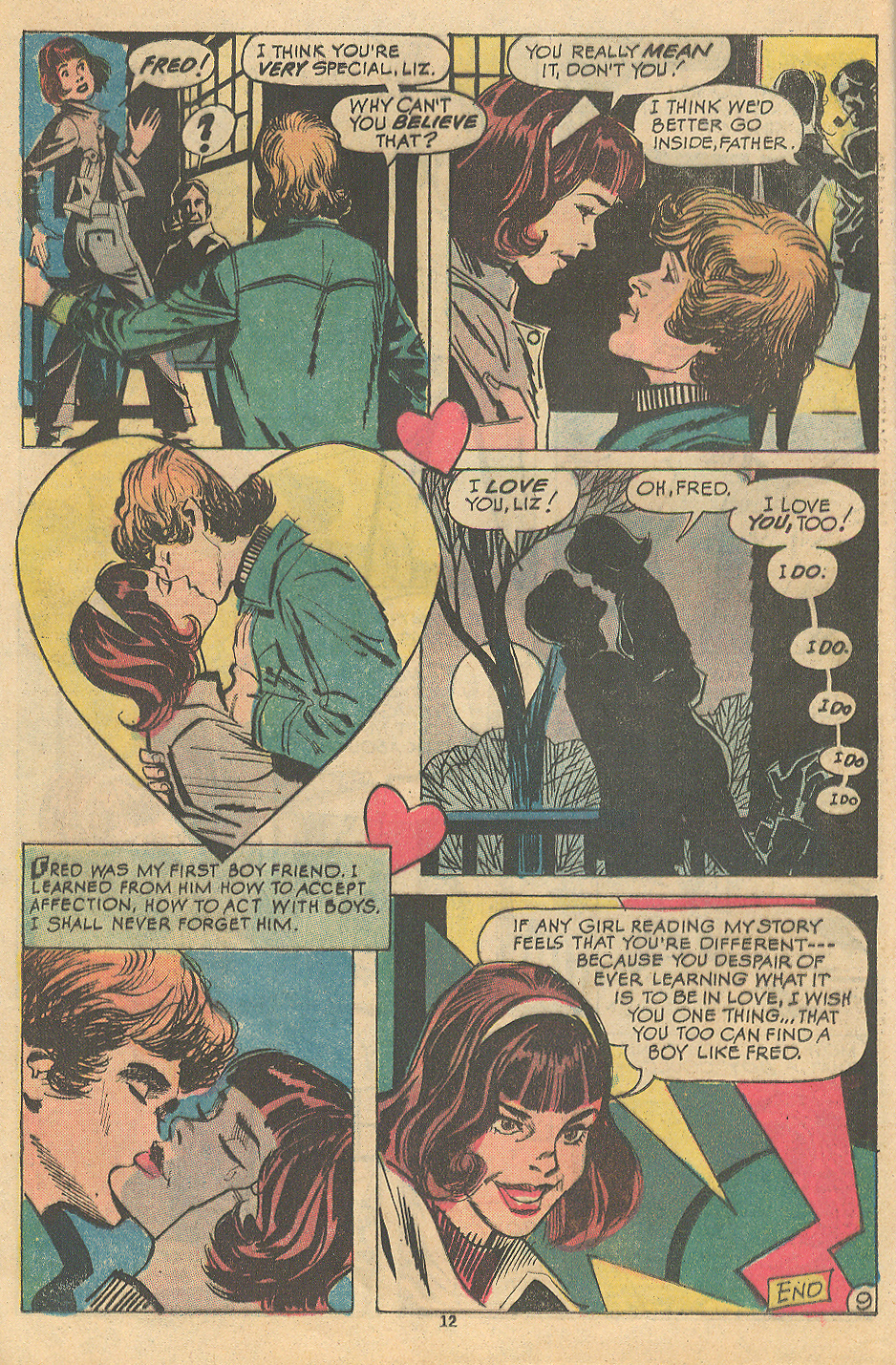Young Romance's "That Strange Girl" - An LGBTQ Romance Comic Book Story - Or Is It?
Today's story, "That Strange Girl" from Young Romance #197 (January/February 1974) with art by Creig Flessel is one of the more "infamous" romance comic book stories of the 1970s. Billed on the cover as "The Story They Dared Us to Print!" it tells the tale of Liz Baker -- tomboy extraordinaire. Enjoy, and be sure to stick around after the story for a few thoughts from yours truly!
The splash page introduces us to narrator and protagonist, Liz. She explains her reasoning for telling the ensuing painful story -- to ease the hurt of other girls like her.
Liz and her father are close. They frequently work on household projects together, including odd jobs for the neighbors. She spends her 16th birthday helping him install a fence. While working on the fence, two classmates walk by. One, named Fred, seems to be interested in Liz. His friend tells him to forget it -- "Liz isn't interested in boys!"
Later that evening, the family has a little birthday party for Liz. Her mother is concerned that they didn't invite any of her friends, but Liz isn't worried. She explains that later that evening, her friend Agnes will be treating her to a movie. Before Liz leaves for the movie, her mother asks her if she has any interest in boys. Liz (who has never gone out with a boy) responds, "Boys are a drag! Besides, I don't have anything to wear." Her mother quickly remedies the wardrobe issue by presenting Liz with a series of the latest fashions -- dresses and "other frilly junk." A fight between mother and daughter ensues when her mother makes an insinuation about her sexuality. Liz leaves the house and spends the night at Agnes's. Liz narrates, "Agnes didn't go out with boys either, but her family was more understanding."
One day at an after-school basketball game, while in the process of executing a lay-up, Liz crashes into Fred Reese. He tells her he will meet her outside the locker room after the game, as he wants her to help him "limp home." A fellow classmate turns to Fred as he waits for Liz and declares, "You must have hit your head, Fred! She doesn't go for boys!" Fred ignores the bully and proceeds to walk with his crush, Liz.
Fred draws Liz in for a kiss, but she quickly pushes him away, feeling frightened and ashamed. Fred asks if she likes him, and she tells him no -- she thinks that he is making fun of her like the rest of their peers. Fred retorts, "Liz, the way you kissed me... you can't be... I mean you have to be normal!" Fred's choice of words infuriates Liz. He then tells her he is in love with her, while Liz simultaneously yells that she hates him. Liz runs home, completely confused about her feelings.
“I was all mixed up inside. Were they right? Was there something wrong with me? I ran home crying, hating them...hating myself!”
Upon returning home, Liz's parents comfort her. Fred appears, having followed Liz back home. He tells her he loves her and kisses her and subsequently, Fred becomes Liz's first boyfriend.
Quite a story, huh?! Flessel really had a knack for capturing the awkwardness of teenage-hood, and his art fits the story of Liz's trials and tribulations perfectly!
I have read this story many times, but I am still not absolutely sure where I stand on its interpretation. On one hand, it does very much seem to a thinly-veiled look into the life of a young lesbian. Just the mere cover blurb, "The Story They Dared Us to Print!" points to a coded story. On the other hand, without knowing the exact intentions of the creators, it could be interpreted more literally -- as a story of the hardships of a "strange" teenage girl. If it is the latter, I can identify.
When I was in high school, I was a little "quirky" you could say. My hair was big, I was cursed with braces, and I was a theater nerd. By no means was I one of the "popular" kids, but I still managed to have a pretty good time. In pursuit of academic and extra-curricular excellence, boys were lower down on the list of priorities. It wasn't that I didn't like them, because I certainly did. I think that any of my high school friends could attest to the fact that I was a wee bit "boy crazy." But, as luck would have it, none of the guys seemed to like me! So I dealt with it, and concentrated on my quest for future fame and world domination -- still workin' on that, by the way! Anyhow, the fact that I didn't have a steady or an endless stream of dates, greatly worried my grandmother. She was like, distraught. And so, she went to my mother with her concerns and I distinctly remember my mom awkwardly insinuating at the behest of her mother, that perhaps I didn't like boys after all. Liz's reaction on the third page, "Mother! How could you?" was my reaction as well. The horror that someone would think I was something I knew I wasn't, stressed me out!
Unfortunately, in this story we learn more about Liz via her bullies than through her. Perhaps if we as the reader would have been privy to more conversations between Liz and her friend Agnes, the story would be more clear cut. Modern inclination may be to get snarky or be mad that romance comics couldn't just be cool with publishing a story of non-heteronormativity. But we have to remember, it was the early '70s and depictions of same-sex relationships were not accepted in mainstream media like they are today -- much less in a venue for adolescent girls.
Which ever way our main girl, Liz swings, she certainly is loveable. She reminds us that being a teenager is hard, and the external and internal pressures to fit in with the crowd creates incredible turmoil in the hearts of the young. In that light, "That Strange Girl" really isn't any different than other comic book romance stories of the 1960s and '70s.
Now that you are familiar with the story, what do you think? Was Liz really as "strange" as everyone made her out to be, or was she just undergoing the typical trials of youth?
Have you checked out my book How to Go Steady yet? It's chock-full of romance and dating advice that we can all relate to!








